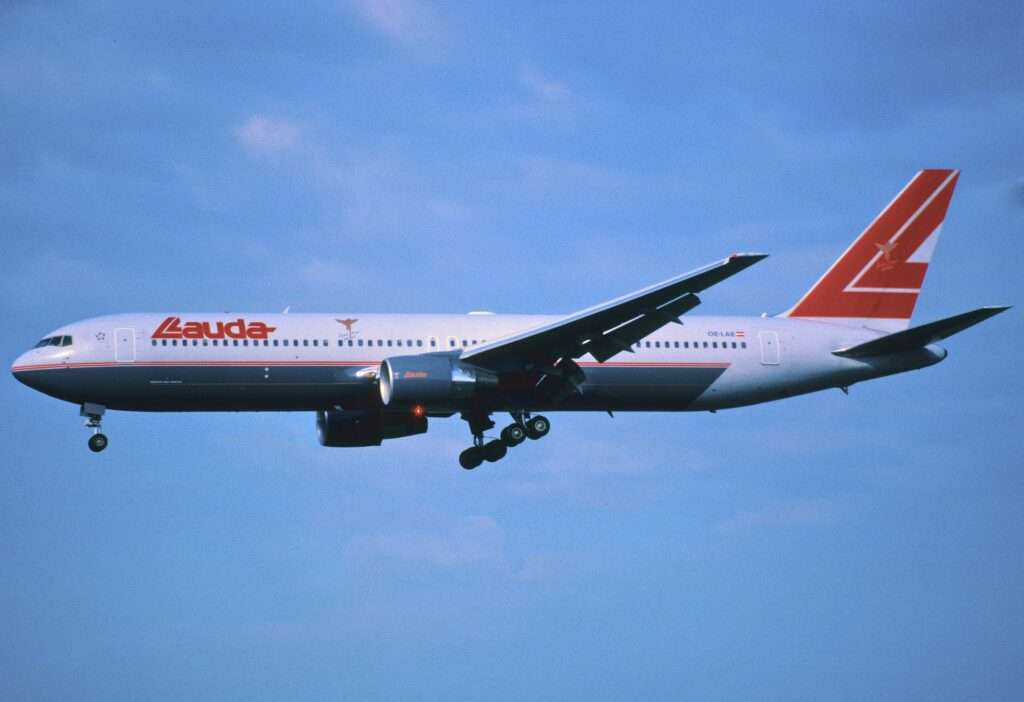30+ Years On Since The Crash in the Jungle
On May 26, 1991, a routine passenger flight from Bangkok to Vienna turned into a devastating tragedy. Lauda Air Flight 004, a Boeing 767-300ER, plunged into the mountainous jungles of Thailand, claiming the lives of all 223 people on board.
The crash marked the deadliest accident involving the Boeing 767 and the worst aviation disaster in Thailand’s history.
A Flight Like Any Other… Until It Wasn’t
Lauda Air, a young Austrian airline, operated three weekly flights between Bangkok and Vienna.
Flight NG004, originating from Hong Kong’s Kai Tak Airport, arrived in Bangkok with 213 passengers and 10 crew members.
Captain Thomas J. Welch, an American, and First Officer Josef Thurner, an Austrian, were at the helm.
Both were experienced and well-regarded pilots.
The flight took off from Don Mueang International Airport in Bangkok shortly after 11:00 PM local time.
The initial climb and communication with air traffic control proceeded normally.
However, just five minutes after takeoff, disaster struck.
A Warning Light and a Devastating Malfunction

The cockpit instruments flickered to life with a “REV ISLN VAL” warning on the Engine Indicating and Crew Alerting System (EICAS) display, accompanied by a loud caution tone.
This cryptic message indicated a potential issue with the thrust reverser isolation valve on the plane’s number one engine.
Thrust reversers are mechanisms on jet engines that can be deployed to slow the aircraft down after landing.
A malfunctioning isolation valve could lead to an unintended deployment of the thrust reverser in mid-air, a scenario that could have catastrophic consequences.
The pilots’ initial reaction was one of confusion, with First Officer Thurner expressing an expletive.
Captain Welch acknowledged the recurring warning light.
Little did they know, this seemingly minor issue was about to spiral into a full-blown emergency.
A Desperate Struggle for Control

Moments after the warning light, the crew’s worst fears materialized.
The number one engine’s thrust reverser inexplicably deployed in mid-air. This sent the aircraft into a sudden and violent left roll.
The sudden loss of lift and control sent Flight 004 into a steep dive.
Captain Welch and First Officer Thurner fought valiantly to regain control.
They deployed the spoilers, ailerons, and rudder in an attempt to counter the roll and stabilize the aircraft.
However, the deployed thrust reverser created a massive amount of drag on one side of the plane, making it almost impossible to recover.
The cockpit voice recorder captured the harrowing moments that followed.
The pilots exchanged frantic calls as they battled the uncontrollable aircraft. The descent became a terrifying plummet towards the unforgiving jungle terrain below.
A Devastating End
The struggle for control was tragically short-lived.
The immense stress on the aircraft due to the violent maneuvers caused a chain reaction of structural failures.
The tail section, unable to withstand the forces, began to break apart.
With the plane disintegrating in mid-air, any hope of recovery vanished.
Lauda Air Flight 004 slammed into the mountainous jungle terrain approximately 94 nautical miles northwest of Bangkok, leaving no survivors.
The Aftermath: A Search for Answers
The crash site was located in a remote and densely forested area, making the search and recovery operation a daunting task.
International teams joined Thai authorities in the effort to locate the wreckage and recover the remains of the victims.
The investigation into the cause of the accident focused on the malfunctioning thrust reverser.
The flight data recorder, which could have provided valuable insights, was completely destroyed in the crash. However, the cockpit voice recorder offered crucial clues.
The investigation revealed that a series of maintenance errors had led to a faulty installation of a crucial valve component.
This defect ultimately caused the uncommanded deployment of the thrust reverser, triggering the catastrophic chain of events.
A Legacy of Change
The Lauda Air Flight 004 accident had a profound impact on the aviation industry.
Boeing, the manufacturer of the Boeing 767, issued new maintenance procedures to ensure the proper installation of the thrust reverser valve.
The accident also highlighted the importance of crew training for handling unexpected emergencies.
Airlines around the world began to incorporate more comprehensive training scenarios that involved in-flight thrust reverser malfunctions.
The tragedy of Lauda Air Flight 004 served as a stark reminder of the importance of aircraft maintenance and pilot training.
The lessons learned from this accident continue to shape aviation safety practices today.

Click the banner to subscribe to our weekly newsleter.

Click the photo to join our WhatsApp channel so then you can stay up to date with everything going on in the aviation industry!

